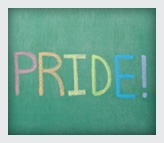LGBT youth
Currently, there is no universally accepted acronym for the lesbian, gay, bisexual, and transgender (LGBT) youth population. This is reflected in the diversity of acronyms used in writings by and about this population. It is important to note that although an acronym may be used as an umbrella term and the experiences and needs of LGBT youth are often grouped together, each of these letters represents a distinct population with particular experiences and concerns.1 For example, some American Indian and Alaskan Native youth who do not identify as heterosexual and/or who do not define their gender based on Western practice may embrace “two-spirit” as a culturally specific identity.2 In addition, challenges experienced by lesbian, gay, or bisexual youth may also be experienced by those questioning their sexual orientation or are perceived to be non-heterosexual. This is also true of youth who do not conform to expected gender behavior and norms, but who are not transgender.
Youth who are lesbian or gay are emotionally and physically attracted to others of the same sex, while youth who are bisexual are attracted to both males and females. In addition, some youth may embrace a gender identity that is different from their birth-assigned gender. These youth may identify as “transgender,” or may simply identify themselves using the gender they feel fits their identity. Youths’ sexual orientation and identity, as well as gender identity and expression, can affect their experiences in their homes, schools, communities, and workplaces. Understanding and expressing one’s sexual orientation, as well as developing a related identity, is a developmental process that varies across children and youth.
Although stories about LGBT youth experiencing support and acceptance from their families, peers, and communities are growing, challenges persist. LGBT youth, as well as youth who may be perceived as LGBT or gender nonconforming,3 may experience physical and emotional bias, violence, and discrimination from their families, or in their schools, employment, and communities.4 They may experience bias and feel depressed and isolated because of inadequate support at home, in school/work, and in their community. Consequently, they are more likely to commit suicide, be homeless, and use illegal drugs because of these environmental challenges.5 It is therefore important to be aware of available information and resources to address these challenges that affect some LGBT youth, while also acknowledging and building on their strengths and resilience.
Federal and local policies and practices are increasingly acknowledging and focusing on LGBT youth, and numerous national advocacy and other organizations are also giving greater attention to LGBT and questioning youth in their work.6 Encouraging greater acceptance and support for all youth, including those who are or are perceived to be LGBT, will make communities, schools, and other settings safer, better places for all youth.
1 Institute of Medicine, 2011
2 Bearse, 2012
3 Gender nonconforming youth are not necessarily LGBT. In fact, any youth who does not fit typical social expectations for his or her mannerisms, behavior, or choice of clothing based on birth-assigned gender, for example, can be considered “gender nonconforming.” This does not mean the youth is LGB or identifies as a gender different than what he or she was assigned at birth (i.e., transgender).
4 Hunter & Schaecher, 1987; Reis, 1999; Reis & Saewyc, 1999
5 Ray, 2006; Ryan, 2009; Ryan, Huebner, Diaz, & Sanchez, 2009
6 American Association of School Administrators, American Federation of Teachers, American School Counselor Association, Association for Supervision and Curriculum Development, National Association of Elementary School Principals, National Association of Independent Schools, . . . United Church of Christ Justice & Witness Ministries, n.d.; National Association of School Nurses, 2003; National Association of School Psychologists, 2006
2 Bearse, 2012
3 Gender nonconforming youth are not necessarily LGBT. In fact, any youth who does not fit typical social expectations for his or her mannerisms, behavior, or choice of clothing based on birth-assigned gender, for example, can be considered “gender nonconforming.” This does not mean the youth is LGB or identifies as a gender different than what he or she was assigned at birth (i.e., transgender).
4 Hunter & Schaecher, 1987; Reis, 1999; Reis & Saewyc, 1999
5 Ray, 2006; Ryan, 2009; Ryan, Huebner, Diaz, & Sanchez, 2009
6 American Association of School Administrators, American Federation of Teachers, American School Counselor Association, Association for Supervision and Curriculum Development, National Association of Elementary School Principals, National Association of Independent Schools, . . . United Church of Christ Justice & Witness Ministries, n.d.; National Association of School Nurses, 2003; National Association of School Psychologists, 2006
Collaboration Profiles
Youth Voices
Feature Articles
Tools & Guides
Technical Assistance
Websites
Publications
Videos & Podcasts
 |
Youth Voices: Amanda "Although it can be scary at first, I’ve found that sharing my experiences has helped adults recognize that I, as well as many other young adults, could help make positive changes to their organizations." |
 |
Youth Voices: endever* "I’m nongender, which for me, means that I don't identify as either male or female." |
 |
June is LGBT Pride Month Lesbian, Gay, Bisexual and Transgender Pride Month (LGBT Pride Month) is celebrated annually in June to honor the 1969 Stonewall riots, and works to achieve equal justice and equal opportunity for lesbian, gay, bisexual, transgender, and questioning (LGBTQ) Americans. |


Announcements

Map My Community is a tool designed specifically to assist you in locating resources in your community to help you build and strengthen your youth program. Get ideas for new partnerships, identify gaps in your community, and learn about resources to avoid duplication of effort.



















